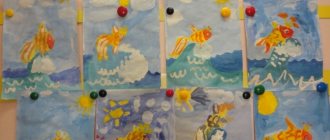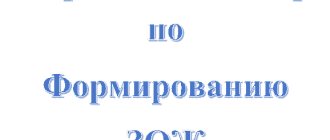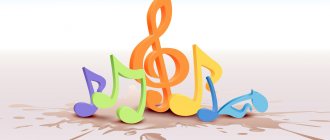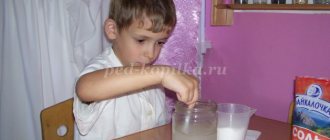Summary of an open lesson on FEMP for middle-aged children “5 Keys”
Summary of an open lesson on FEMP for children in the middle group “Five Keys”
Age
: 4-5 years
Integration of educational areas
: cognitive, speech and social-communicative development;
Target:
the formation of elementary mathematical concepts, constructive abilities, communication skills, and expand the active vocabulary of children.
Tasks:
Educational:
consolidate the ability to count within 5, introduce the ordinal value of a number, teach how to correctly answer the questions “How much?”, “Which one?”; improve the ability to distinguish and name geometric shapes: circle, square, triangle, oval, rectangle; consolidate knowledge of flowers; consolidate knowledge about the parts of the day;
continue to develop constructive skills (construct from geometric shapes).
Developmental:
develop attention and memory; consolidate the ability to correctly use generalizing concepts (classification);
Educational:
to cultivate goodwill in children in communicating with peers and adults;
Demo material:
a chest with five locks, five keys, a small glass jar with clear water, blue cloth (lake), five fish of different colors with numbers from 1 to 5; napkin, pictures with parts of the day, model of a tree, easel, “Aibolit” slides, “objects made from geometric shapes;
Handout:
hedgehogs, apples (5 pieces for each child);
Methodical techniques:
game situation, problem statement, conversation-dialogue, speech game, physical education session, experiment with water in a jar, analysis, summing up.
Secret experiment with water. In order for colored water to appear in a jar after clear water, you need to apply thick gouache to the lid of the jar. After you shake or shake the closed jar, colored water will appear in it.
Progress of the lesson
The children stand in a semicircle.
Educator:
Guys, we have guests today.
Say hello. (Greet greetings to guests).
Educator:
Guys, today a package with a letter arrived in our group. And who it came from, you will find out if you guess the riddle:
This is a very kind doctor.
The animals send him greetings.
He goes into any distance,
If someone calls.
He doesn't sit idle -
Our beloved... (Aibolit)
«Hello guys! Help me please.
Animals in Africa are sick. I took the magic water and was about to set off, but the evil pirates took my chest from me! They locked the chest with five locks and hid the keys. If you agree to help me, then you have to complete five tasks. For each task completed correctly, you will receive a key. Having collected all the keys, you can open the chest with magic water. I would go on the journey with you myself, but sick animals are waiting for me. I really hope for you! When you complete the task, send me magic water! Aibolit."
(the teacher opens the parcel, takes out the chest and looks at it with the children - there are five locks on it);
Educator:
Guys, let's help Aibolit?
( children's answer) .
Then we hit the road to the lake.
Look, fish are swimming in the lake. We need to get them. Here is our first task
. The fish must be placed in order (the teacher names the child, Find the fish with the number 1, 2, 3, 4, 5, what color is the fish number 1, etc.)
- Well done! We've done it, here's the first key!
(after each task, the children, together with the teacher, open one lock)
Task 2.
Game “Parts of the Day” (“Finish the sentence”)
- Look, what is that glittering on our tree? (key) and some bird is sitting on a tree. What kind of bird is this? (magpie) But she doesn’t want to give us the key. She prepared riddles for us. If we guess right, he will give back the key.
- Now I’m not going to read the sentence to you completely, you must finish it:
— We sleep at night, and do exercises... (in the morning)
- We have breakfast in the morning, and lunch... (in the afternoon)
- We have lunch during the day, and have dinner... (in the evening)
- We have dinner in the evening, and sleep... (at night)
- How many parts are there in a day? (4). Name them.
Educator:
Well done! You were so good at solving riddles! Here is the second key for the correct answers.
Now the third task.
Task 3.
Educator:
Children, you and I have come to the forest school. Guys, come to the tables. Sit down, keep your backs straight, legs tucked under the table (saving health - posture); There are pictures in front of you. Here's the task: post pictures of hedgehogs. How many hedgehogs did you get? (Children's answer). Right. What do hedgehogs like to eat? That's right, mushrooms and apples. Let's treat the hedgehogs with apples. (Children lay out apples). Did all the hedgehogs have enough apples? (Children's answers). How many apples do we have? How many hedgehogs? What should we do so that there are equal numbers of hedgehogs and apples? That's right, you need to add one apple or remove one hedgehog. Let the first table imagine that one hedgehog ran away, and the second table that the hedgehog found himself an apple. What have we got now? (Children's answers).
- Well done guys! Mission accomplished! Here is the third (and fourth) key (under the table where the children are sitting there is a basket with keys, covered with a napkin);
Educator:
And now it's time for us to rest. I invite you to the carpet.
PHYSICAL MINUTE
On Monday I swam (pretend swimming) And on Tuesday I painted. (pretend to draw) On Wednesday I took a long time to wash my face, (we wash my face) And on Thursday I played football. (running in place) On Friday I jumped, ran, (jump) danced for a very long time. (spinning in place) And on Saturday, Sunday (claps hands) I rested all day. (children squat down with their hands under their cheeks and fall asleep.)
Educator:
Well guys, have a rest! It's time to start the next task.
Task 4. “In the land of geometric shapes”
Educator:
Guys, let's go to the monitor and look at the slide. What do you see? (picture) What’s unusual about it? (the picture consists of geometric shapes) Let's describe it (describe the slide)
Educator:
Well done boys! For this you receive the fifth key.
So guys, how many keys do we have? (Five).
Now we have to open the last lock of the chest, open it and get the magic water.
Children and their teacher open the chest and take out magic water. (It's transparent).
Educator:
In my opinion, this is ordinary water. Wait, there's another note.
“If you shake the jar, the water will become magical. Urgently send magic water to me in Africa. And for you, kids, there’s a surprise in the chest, magic candies” (at the bottom of the chest is a treat for the kids).
Our adventure has come to an end. Let's remember what we did today? They helped Aibolit (they looked for keys - there are 5 of them), laid out the fish (how many were there? what color), guessed the parts of the day (what parts were they? morning, day, evening, night), solved a problem about hedgehogs and apples (how many hedgehogs were there? everyone were there enough apples? what did we do so that there were equal numbers of apples and hedgehogs? we found another apple and the extra hedgehog ran away), looked at a picture of geometric shapes; what figures did we meet? (circle, square, rectangle, oval, triangle) Did you like it? What did you like most? (children's answers).
- Let's say goodbye to the guests
Romanova Vitalina Anatolyevna, teacher,MBDOU DS No. 10 "Lazorik" of the city of Donetsk, Rostov region
Category "Work Experience"
Self-analysis of the lesson on FEMP “Journey through Mathematics”
Self-analysis of the lesson on FEMP “Journey through Mathematics”.
We have brought to your attention a lesson on the formation of elementary mathematical concepts in children of the preparatory group.
In my lesson, I set myself the following educational goals:
— Exercise children in forward, backward, ordinal counting.
— The composition of a number from two smaller ones, previous and subsequent numbers, which number is greater, less.
- Ability to make a sum from two smaller ones.
— Measuring length with a ruler.
— Solving a problem using numbers and signs with “-” and “+”.
— Develop logical thinking.
— Cultivate a desire to show acquired knowledge and interest in the lesson.
The children were told the topic of the lesson. The structure of the lesson corresponded to the assigned tasks. It is built in a logical sequence and interconnection of the parts of the lesson. The pace of the lesson is optimal. Speech rate is moderate. The material was presented emotionally. I selected the necessary visual aids and handouts.
When planning an open lesson, the age characteristics of the children were taken into account. The material is selected at a level accessible to children. Taking into account their age characteristics, the children answered the teacher’s questions, maintained a conversation, watched with interest, examined them, and willingly took on tasks. The children were quite active, felt comfortable, and willingly took part in the lesson.
All elements of an open lesson are united by a common theme. The content of the lesson corresponded to the goals set.
During the open lesson, the following working methods were used: verbal (questions, clarification, reminder, encouragement); visual demonstration (pictures and illustrations); game.
The main part of the lesson is aimed at the development of cognitive activity, the formation of mental and practical actions. Having set specific tasks for the children, she sought from each child (depending on his capabilities) their implementation, monitored the completion of tasks, made adjustments to their knowledge, provided the necessary assistance, and encouraged even minimal success. The volume of educational material ensured the children's activity and pace of work during the lesson. Its content corresponded to the purpose of the lesson, was scientific and at the same time accessible to children. To relieve general fatigue, a ball game was played.
The final part summarized the lesson.
I believe that the form of organizing classes for children that I chose was quite effective. I tried to comply with the norms of pedagogical ethics and tactics. I believe that the objectives set during the lesson were completed.



